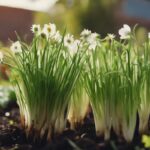Plants
Best Companion Plants for Tomatoes Guide
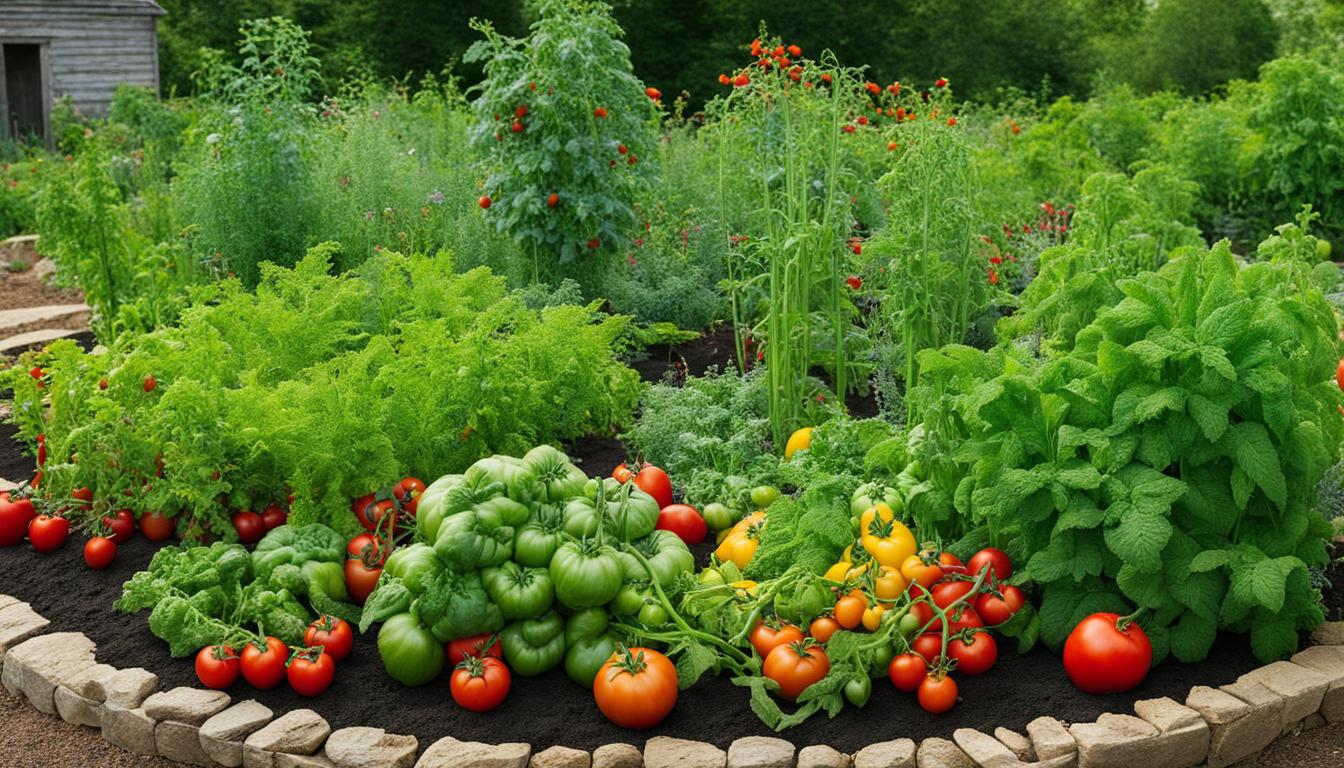
Many gardeners have a keen interest in discovering companion plants that can effectively improve the growth and health of tomatoes in their gardens. These plants not only serve as natural pest repellents, but also attract beneficial insects, prevent diseases, and enhance the flavor of tomatoes. Companion planting involves strategically growing specific plants in close proximity to each other for mutual benefit. In this guide, we will delve into the top companion plants for tomatoes backed by thorough research and expert advice from various sources.
Key Takeaways:
- Companion planting with tomatoes offers several benefits, including attracting beneficial insects and repelling pests.
- Marigolds can naturally deter insects like tomato hornworms and aphids.
- Garlic and onions act as natural pest repellents and help protect tomato plants.
- Lavender can repel mosquitoes and attract pollinators like bees.
- Basil helps control pests and enhances the flavor of tomatoes.
The Benefits of Companion Planting with Tomatoes
Companion planting with tomatoes offers invaluable advantages for your garden. By strategically selecting and growing companion plants alongside your tomatoes, you can create a harmonious environment that promotes healthy growth and enhances the overall productivity of your vegetable patch. Let’s explore the remarkable benefits of companion planting with tomatoes, backed by research and experienced gardeners.
Promotes Pollination and Improved Yields
One of the significant benefits of companion planting with tomatoes is the attraction of beneficial insects, particularly pollinators, to your garden. Companion plants such as flowers and herbs can entice bees, butterflies, and other pollinators that aid in the fertilization of tomato flowers, resulting in higher fruit yields and better quality produce.
Natural Pest Repellents
Companion plants also act as defenders of your tomato plants, naturally deterring pests that might otherwise feast on your precious crops. By interplanting certain flowers, herbs, or vegetables with tomatoes, you can effectively repel pests and reduce the need for pesticides. This not only benefits the health of your tomato plants but also promotes a more eco-friendly approach to gardening.
Natural Fungicides and Disease Prevention
Certain companion plants possess natural fungicidal properties that can help prevent diseases from affecting your tomatoes. By growing these plants alongside your tomatoes, you create a protective barrier that wards off common tomato ailments. This can significantly enhance the overall health and vigor of your tomato plants, reducing the risk of fungal infections and ensuring better crop yield.
Improves Flavor and Culinary Combinations
In addition to the practical benefits, companion plants can enhance the flavor and culinary appeal of your tomatoes. Some companion plants, such as herbs like basil or parsley, can complement the taste of tomatoes in recipes, making them an excellent choice for gardeners who enjoy cooking and using fresh ingredients from their own backyard.
Enhances Ecosystem and Biodiversity
Companion planting with tomatoes contributes to a thriving and diverse ecosystem in your garden. By introducing a variety of plants, you attract an array of beneficial insects, including pollinators and predators of unwanted pests. This creates a balanced ecosystem that supports the health and vitality of your garden, reducing the reliance on chemical interventions and fostering a more sustainable gardening approach.
By capitalizing on the benefits of companion planting with tomatoes, you can optimize the health and productivity of your garden while enjoying tastier, more abundant tomatoes. However, it’s important to note that not all plants make suitable companions for tomatoes, and compatibility should be considered when designing your garden layout. Below is a table summarizing the benefits of companion planting with tomatoes and some recommended companion plants:
| Advantages of Companion Planting with Tomatoes | Recommended Companion Plants |
|---|---|
| Enhanced pollination and yield improvement | Sunflowers, borage, bee balm |
| Natural pest repellents | Marigolds, garlic, onions |
| Natural fungicides and disease prevention | Parsley, thyme, rosemary |
| Flavor enhancement and culinary combinations | Basil, oregano, chives |
| Promotes ecosystem and biodiversity | Lavender, dill, yarrow |
By incorporating these companion plants into your tomato garden, you can create a dynamic and thriving ecosystem that benefits your tomatoes and the overall health of your garden. The advantages of companion planting with tomatoes extend beyond the individual plants’ benefits, creating a holistic gardening approach that promotes sustainability and harmony.
Marigolds – Natural Insect Deterrents
Marigolds are an excellent choice as companion plants for tomatoes. Their bright colors and strong scent make them effective in deterring insects such as tomato hornworms and aphids. These pests are naturally attracted to the marigolds instead of the tomatoes, providing a protective barrier for the fruit.
Using marigolds with tomatoes has multiple benefits. Beyond repelling harmful insects, marigolds also attract beneficial insects like ladybugs and hoverflies, which feed on aphids and other common garden pests. This natural pest control helps to promote a healthier tomato plant and reduces the need for chemical pesticides.

It’s important to note that while marigolds are effective in repelling harmful insects, they can attract other pests, such as spider mites. To maximize the benefits of marigolds, consider planting a row of marigolds around your tomato plants to create a barrier that insects are less likely to cross.
Garlic and Onions – Natural Pest Repellents
When it comes to protecting your tomato plants from pests, garlic and onions are your allies. These pungent alliums serve as natural pest repellents, keeping insects at bay and safeguarding your tomato crop. The strong odor emitted by garlic and onions deters various pests, including moths, cabbage loopers, and root maggots, which can cause significant damage to tomato plants.
By planting garlic and onions alongside your tomatoes, you create a powerful defense system that helps to maintain the health and productivity of your garden. Not only will these companion plants repel harmful insects, but they also offer other benefits to your tomato plants.
“Garlic and onions add a layer of protection to your tomatoes, safeguarding against pest infestations and potential damage.”
The use of garlic and onions as companion plants for tomatoes has been widely recognized for their pest repellent properties. However, it’s important to note that if you’re dealing with thrips in your garden, you should avoid planting onions, leeks, or garlic near your tomatoes. Thrips are tiny insects that feed on the juices of plants and can cause damage to both your tomato plants and the root vegetables themselves.
The Benefits of Garlic and Onions as Companion Plants
The presence of garlic and onions in your garden offers several advantages for your tomatoes:
- Natural pest repellent: The strong scent of garlic and onions repels insects, helping to protect your tomato plants from pests such as moths, cabbage loopers, and root maggots.
- Reduced pesticide use: By relying on the natural pest-repellent properties of garlic and onions, you can minimize the need for chemical pesticides in your garden, promoting a healthier and more sustainable growing environment.
- Improved flavor: Garlic and onions can enhance the flavor of your tomatoes. When grown together, these companion plants can contribute to the development of more robust and complex flavors in your tomatoes, enhancing your culinary experience.
Overall, incorporating garlic and onions as companion plants for your tomatoes not only protects them from pests but also adds flavor to your harvest. The pungent aroma of these alliums acts as a natural deterrent, warding off unwanted insects and ensuring the well-being and productivity of your tomato plants.
Lavender – Pest Repellent and Pollinator Attractor
Lavender is a fantastic companion plant for tomatoes, thanks to its incredible properties. Not only does lavender add a beautiful touch to your garden with its sweet-smelling flowers, but it also serves as a natural pest repellent. The scent of lavender is known to repel mosquitoes and other flying pests, creating a more enjoyable outdoor environment for you and your plants.
But that’s not all! Lavender also helps protect your tomatoes from aphids, those pesky little insects that can wreak havoc on your plants. By planting lavender near your tomatoes, you can keep aphids away, preventing them from causing damage and stunting the growth of your tomatoes.
Another incredible benefit of lavender is its ability to attract pollinators, particularly bees. Bees are essential for the pollination of tomatoes, which is crucial for optimal fruit yield and quality. By incorporating lavender into your garden, you create a welcoming environment for bees, ensuring that your tomatoes are well-pollinated and produce robust, delicious fruits.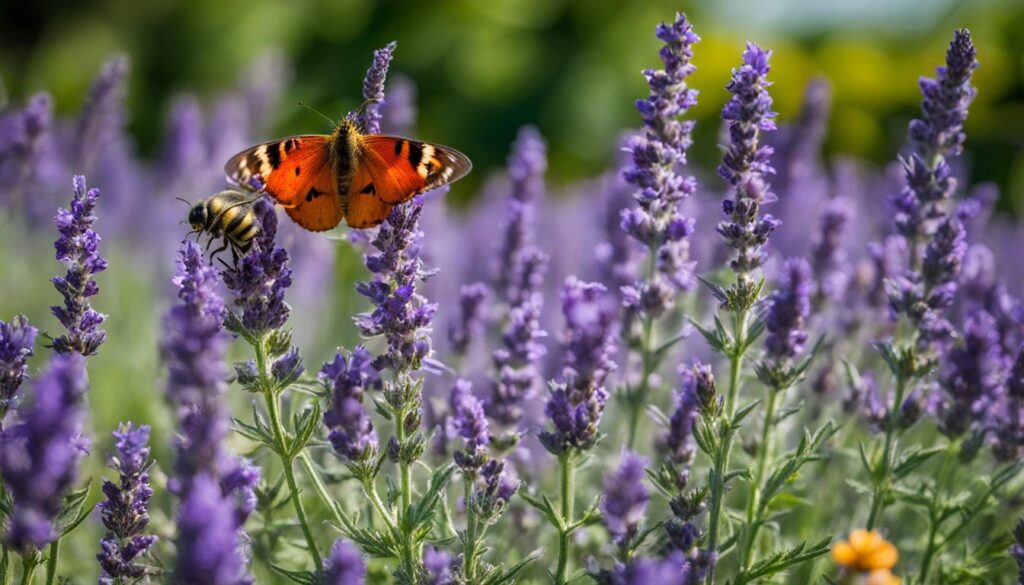
Incorporating lavender into your tomato garden not only benefits your plants but also adds a touch of beauty and tranquility to your outdoor space. The vibrant purple blooms of lavender can create a stunning visual contrast against the green foliage of your tomato plants. So, why not enhance your garden with the aromatic allure of lavender and enjoy the numerous benefits it brings?
Lavender and Mosquitoes
Lavender is a natural mosquito repellent. Its fragrant flowers emit a scent that these bothersome insects find repulsive. By planting lavender near your tomatoes, you can help create a more mosquito-free environment in your garden.
Lavender and Aphids
Aphids are a common problem for tomato plants, as they suck sap from the leaves and stems, causing stunted growth and the development of mold. Lavender acts as a natural deterrent for aphids, keeping them away from your tomatoes and preserving the health of your plants.
Lavender and Pollinators
Bees are vital pollinators for tomatoes, helping to transfer pollen from one flower to another, resulting in the formation of fruits. Lavender’s sweet-smelling flowers are irresistible to bees, attracting them to your garden and ensuring optimal pollination for your tomatoes.
| Lavender Benefits | Keywords |
|---|---|
| Pest Repellent | lavender as a companion plant for tomatoes |
| Pollinator Attractor | using lavender with tomatoes |
| Protects Against Aphids | benefits of planting lavender with tomatoes |
| Repels Mosquitoes | lavender and mosquitoes |
| Enhances Fruit Yield and Quality | lavender and pollinators |
Basil – Pest Control and Enhanced Flavor
Basil is a versatile companion plant when it comes to growing tomatoes. Not only does it provide natural pest control, but it also enhances the flavor of your tomatoes. Basil contains eugenol oil in its leaves, which gives it a distinctive aroma and helps repel mosquitoes. When planted alongside tomatoes, basil acts as a natural deterrent for common tomato pests such as aphids, spider mites, and thrips.
Basil’s aromatic properties make it an effective companion in keeping these harmful insects away from your tomato plants. It’s a win-win situation because you not only protect your tomatoes from damage, but you also benefit from having fresh basil leaves for culinary uses. The combination of basil and tomatoes in recipes like Caprese salad or pesto sauce is simply delicious.
By incorporating basil into your tomato garden, you create a natural pest control solution that helps protect your plants and enhances their overall flavor. The aromatic oils in basil leaves keep mosquitoes and pests at bay, while the flavorful leaves add depth and complexity to your tomato-based dishes.
Companion Plants to Control Tomato Pests
| Companion Plant | Pest-Control Benefits |
|---|---|
| Basil | Repels aphids, spider mites, and thrips |
| Marigolds | Deters tomato hornworms and aphids |
| Garlic and Onions | Repel insects like moths, cabbage loopers, and root maggots |
| Lavender | Repels mosquitoes and attracts pollinators |
| Chives | Repel aphids and spider mites |
| Asparagus | Produces natural fungicides and deters asparagus beetles |
| Celery | Deters pests that eat tomatoes |
| Parsley | Attracts hoverflies, which feed on aphids |
| Peppers | Compatible with tomatoes and great for salsa |
“Basil’s aromatic properties make it an effective companion in keeping harmful insects away from your tomato plants.”
Adding basil to your tomato garden not only provides natural pest control but also enhances the flavor of your tomatoes, making it an invaluable companion for any tomato enthusiast.
Chives – Predatory Insect Deterrent
Chives are another great companion plant for tomatoes. They produce natural oils in their leaves that give off an onion-like odor when crushed or brushed up against. This distinctive scent acts as a deterrent to predatory insects like aphids and spider mites, effectively protecting your tomato plants from their damaging effects. By planting chives alongside tomatoes, you can create a natural defense system that helps deter these harmful insects and promote the overall health of your garden.
Chives are known for their versatility and ability to thrive in different conditions, making them an ideal choice for tomato companion planting. Not only do they offer protection against aphids and spider mites, but their flavorful leaves can also be used to enhance the taste of your tomato dishes. Whether you’re growing tomatoes for their juicy fruits or tangy sauces, chives make for an excellent companion plant.
“Planting chives alongside tomatoes can help deter harmful insects and improve the overall health of your garden.”
In addition to their pest-repellent properties, chives are also aesthetically pleasing, with their slender green leaves and delicate purple flowers adding visual interest to your garden. They can be easily grown from seeds or transplanted seedlings and require minimal maintenance once established. Chives are also a perennial herb, meaning they will come back year after year, providing a long-lasting companion for your tomato plants.
To make the most of chives as a companion plant, consider placing them strategically throughout your tomato garden. Plant them near the edges of your tomato beds or in between tomato plants to create a barrier that insects are less likely to cross. This will help protect your tomatoes from infestations and reduce the need for chemical pesticides.

| Benefits of Planting Asparagus with Tomatoes: |
|---|
| Repels asparagus beetles |
| Produces a natural fungicide against diseases like early blight and botrytis |
| Prevents root-knot nematodes in the soil |
Celery – Bug-Deterring Companion
Celery is a great companion plant for tomatoes. Not only does it add texture and flavor to your meals, but it also plays a significant role in deterring bugs that love to feast on tomato plants. The scent of celery acts as a natural bug repellent, discouraging pests from getting near your precious tomatoes.
By planting celery near your tomatoes, you create a harmonious garden where these two plants work together to keep insects at bay. The strong aroma of celery can deter a variety of bugs, including aphids, whiteflies, and tomato hornworms, which are known to cause damage to tomato plants.
Celery’s bug-deterrent qualities help protect your tomato plants from potential infestations and reduce the need for chemical pesticides. By implementing companion planting strategies with celery, you can create a more sustainable and eco-friendly garden.
In addition to its bug-repelling properties, celery also offers moisture to the soil. Its deep root system helps draw water and nutrients from deeper layers, benefiting neighboring tomato plants. This characteristic makes celery an ideal companion plant, as it can support the overall health and vitality of your tomato garden.
Consider planting celery alongside your tomatoes to take advantage of its bug-deterring qualities and to create a beautiful and thriving garden. The combination of the aromatic celery and the juicy tomatoes will not only provide you with delicious ingredients for your meals but also contribute to a vibrant and pest-free garden environment.
| Companion Plants | Benefits |
|---|---|
| Celery | Deters bugs that love to eat tomatoes |
| Tomatoes | Provides juicy and flavorful fruits |
Quotes:
“The scent of celery deters pests and can help protect your tomato plants.” – Gardening Expert
“By implementing companion planting strategies with celery, you can create a more sustainable and eco-friendly garden.” – Horticulture Specialist
- Provides bug-deterrent qualities
- Supports overall health of tomato plants
- Reduces the need for chemical pesticides
- Contributes to a vibrant and pest-free garden environment
Parsley – Aphid Control
Parsley is an effective companion plant for tomatoes when dealing with aphids that can destroy your tomato plants. By planting a barrier of parsley, you can attract hoverflies, which happen to have aphids as their favorite food. The presence of parsley can help control aphid populations and protect your tomatoes from damage.
However, it’s important to note that not every tomato variety pairs well with parsley. Before planting them together, it’s recommended to do some research to ensure compatibility and maximize the benefits of this companion planting strategy.
The Benefits of Parsley for Tomato Plants
Parsley offers several advantages when used as a companion plant for tomatoes:
- Aphid Control: The presence of parsley can attract hoverflies, which are natural predators of aphids. Hoverflies lay their eggs near aphid colonies, and their larvae voraciously feed on aphids, helping to eliminate these destructive pests.
- Increased Tomato Health: By controlling aphid populations, parsley can help protect your tomato plants from aphid-related diseases. Fewer aphids mean a lower risk of diseases like mosaic virus and powdery mildew affecting your tomatoes.
- Natural Pest Management: Growing parsley alongside tomatoes encourages a diverse ecosystem in your garden. This can attract other beneficial insects, such as ladybugs and lacewings, which prey on a variety of garden pests, including aphids.
- Flavor Enhancement: Parsley’s unique flavor can also enhance the taste of your tomato dishes. Whether added fresh or dried, parsley can complement the flavors of tomatoes, enhancing your culinary experience.
“Plant parsley as a companion for your tomatoes and enjoy the benefits of natural aphid control, improved tomato health, and a flavorful harvest.” – Gardening Expert
Integrating parsley into your tomato garden is not only beneficial for your plants but also adds interest and diversity to your overall garden design. With its edible leaves and attractive appearance, parsley is a valuable addition to any vegetable garden.
Peppers – Compatibility and Salsa Ingredients
Peppers and tomatoes are often considered compatible plants that can be grown together with great success. Both of these vegetables belong to the nightshade family, which means they have similar growth requirements and thrive in similar conditions. This makes them natural companions in the garden.
One of the benefits of planting peppers alongside tomatoes is that they can be harvested together and used to make delicious salsa. The combination of tomatoes’ juicy sweetness and peppers’ spicy kick creates a mouthwatering flavor that can elevate any dish.
However, it’s important to keep in mind that both peppers and tomatoes can be susceptible to certain diseases, especially when grown in close proximity. As members of the nightshade family, they share some common vulnerabilities. It’s essential to monitor the health of your plants closely and take appropriate measures if necessary to prevent the spread of diseases.
Now, let’s take a look at the compatibility between peppers and tomatoes in terms of flavor and characteristics:
| Pepper Varieties | Tomato Varieties | Flavor Profile |
|---|---|---|
| Bell Peppers | Beefsteak Tomatoes | Mild and sweet |
| Jalapeno Peppers | Roma Tomatoes | Medium heat |
| Serrano Peppers | Cherry Tomatoes | Hot and tangy |
The combination of different pepper varieties and tomato varieties can create a diverse range of flavors in your salsa. From mild and sweet to hot and tangy, there’s a perfect pairing for every taste preference.
Remember, when growing nightshade family plants like peppers and tomatoes together, it’s important to rotate your crops annually to prevent the buildup of pests and diseases in the soil. This practice helps maintain the overall health of your garden and ensures continued success in future growing seasons.
So go ahead and plant some peppers alongside your tomatoes, reap the benefits of their compatibility, and enjoy the flavorful results in your homemade salsa!
Plants to Avoid Next to Tomatoes
While companion plants can enhance the growth of tomatoes and improve the overall health of your garden, there are certain plants that should be avoided as they can inhibit tomato growth or compete for nutrients in the soil. Planting these incompatible companion plants near tomatoes can potentially hinder their growth and increase the risk of diseases. Here are some plants to avoid planting next to tomatoes:
- Dill: Dill attracts tomato hornworms, which can cause significant damage to tomato plants. Keep dill away from your tomatoes to prevent infestation.
- Eggplant: Eggplants belong to the same family as tomatoes (nightshades) and can compete for nutrients in the soil. Avoid planting them near your tomatoes to prevent nutrient deficiencies.
- Brussels sprouts: Brussels sprouts release chemical compounds that can inhibit the growth of neighboring plants, including tomatoes. Keep them separate to avoid stunted tomato growth.
- Cabbage: Cabbage and other members of the brassica family can attract pests like aphids and cabbage worms, which can then spread to your tomato plants. Keep cabbage at a distance from tomatoes to minimize pest issues.
- Corn: Corn is a heavy feeder and can compete with tomatoes for nutrients in the soil. Plant them in separate areas to avoid nutrient deficiencies in both crops.
- Cucumber: Cucumbers have similar water and nutrient requirements as tomatoes and can compete for resources. Plant them in separate areas to ensure healthy growth for both crops.
- Potatoes: Potatoes are susceptible to many of the same diseases as tomatoes, including late blight. To prevent the spread of disease, avoid planting them near tomatoes.
- Strawberries: Strawberries can compete with tomatoes for nutrients and can also attract pests such as slugs, which can damage tomato plants. Keep them separate to ensure optimal growth for both crops.
- Cauliflower: Cauliflower requires similar soil conditions to tomatoes and can compete for nutrients in the soil. Plant them in separate areas to prevent nutrient deficiencies.
- Broccoli: Broccoli is another member of the brassica family that can compete with tomatoes for nutrients in the soil. Separate them to avoid nutrient deficiencies in both crops.
By avoiding these incompatible companion plants, you can ensure the health and productivity of your tomato plants. Plan your garden carefully and consider the specific needs of your tomato plants to create a thriving and bountiful harvest.
Other Considerations and Helpful Tips
When selecting companion plants for tomatoes, it’s important to consider several factors to ensure successful companion planting and maximize your tomato garden’s potential. Here are some tips and considerations to keep in mind:
1. Growth Requirements and Compatibility
Choose companion plants that have similar growth requirements to tomatoes. This includes factors such as sunlight, water, and soil conditions. Plants that thrive in similar environments are more likely to coexist harmoniously, creating a favorable ecosystem in your garden.
2. Pests and Diseases
Identify the specific pests and diseases that commonly affect tomatoes in your region. Select companion plants that can help deter or control these pests and diseases. For example, planting garlic or onions alongside tomatoes can repel insects that harm both plants.
3. Crop Rotation
Rotate your crops each year to prevent the buildup of pests and diseases in the soil. This practice disrupts the life cycles of harmful organisms and helps maintain the health of your tomato plants. Avoid planting tomatoes in the same spot for consecutive seasons.
4. Companion Planting Guidelines
Familiarize yourself with companion planting guidelines specific to tomatoes. Some plants may have adverse effects on tomatoes when planted together. For instance, dill and tomatoes should be kept apart as they can inhibit tomato growth. Do your research to ensure optimal companion plant combinations.
By considering these tips and guidelines, you can create a productive and thriving tomato garden with successful companion planting. Experiment with different companion plants to find the best combinations for your specific garden conditions and enjoy the benefits of a well-planned tomato garden.
Compatible Companion Plants for Tomatoes
| Companion Plant | Benefits |
|---|---|
| Marigolds | Repel pests such as tomato hornworms and aphids |
| Garlic and Onions | Act as natural pest repellents |
| Lavender | Repel mosquitoes and attract pollinators |
| Basil | Control pests and enhance tomato flavor |
| Chives | Repel predators such as aphids and spider mites |
| Asparagus | Repel pests and prevent diseases in tomatoes |
| Celery | Deter bugs that eat tomatoes |
| Parsley | Control aphid populations in tomatoes |
| Peppers | Compatible plants and key salsa ingredients |
Conclusion
Companion planting with tomatoes offers a multitude of benefits for your garden. By strategically selecting and integrating companion plants, you can create a thriving ecosystem that enhances the growth and overall health of your tomato plants. Not only can companion plants attract beneficial insects to pollinate your tomatoes and repel pests, but they can also act as natural fungicides and improve the flavor of your harvest.
When choosing companion plants, it’s important to consider their compatibility with tomatoes and their ability to address specific garden challenges. Marigolds, garlic, onions, lavender, basil, chives, asparagus, celery, parsley, and peppers are among the top choices for companion plants that provide pest deterrence, disease prevention, and enhanced flavor. However, it’s essential to avoid planting incompatible plants such as dill, eggplant, cabbage, corn, strawberries, and broccoli near your tomatoes.
Experimentation with different combinations of companion plants is key to finding the best synergy for your unique garden conditions. Remember to rotate your crops each year to maintain soil health and minimize the risk of pests and diseases. With a well-planned companion planting approach, you can maximize the productivity and enjoyment of your tomato garden, reaping the rewards of juicy, flavorful tomatoes. Yes, umbrella plants can be used as companion plants for tomatoes. Their tall, leafy presence provides shade and protection for the tomato plants, helping them thrive. To ensure success, it’s essential to follow umbrella plant care comprehensive guidelines to keep them healthy and happy in the shared environment. Companion plants for tomatoes are other plants that are grown alongside tomato plants to create a mutually beneficial relationship. These companion plants can attract beneficial insects, repel pests, prevent diseases, improve flavor, and increase fruit yield. Companion planting with tomatoes offers several benefits. It can attract beneficial insects for pollination, repel pests that eat tomato plants, act as natural fungicides to prevent diseases, and enhance the flavor of tomatoes. Companion plants can also help create a healthier garden ecosystem overall. Marigolds are excellent companion plants for tomatoes because their bright colors and strong scent deter insects like tomato hornworms and aphids. By planting a row of marigolds around your tomatoes, you can create a barrier that insects are less likely to cross. Garlic and onions are natural pest repellents and can help protect tomato plants from insects like moths, cabbage loopers, and root maggots. Their strong odor repels these pests, reducing the risk of damage to the tomatoes. Lavender is a beneficial companion plant for tomatoes as its sweet-smelling flowers repel mosquitoes and other flying pests. It can also attract bees, which are important pollinators for tomatoes and can lead to better fruit yield and quality. Basil is a versatile companion plant for tomatoes as it helps control pests like aphids, spider mites, and thrips. It contains eugenol oil in its leaves, which gives basil its distinctive smell and helps repel mosquitoes. Many gardeners also find that growing basil near tomatoes enhances their flavor. Chives are a great companion plant for tomatoes because they produce natural oils in their leaves that give off an onion-like odor when crushed or brushed up against. This odor repels predators like aphids and spider mites, protecting tomato plants. Asparagus and tomatoes have a symbiotic relationship. Asparagus produces a natural chemical that repels the asparagus beetle, a common pest. In turn, asparagus also produces a natural fungicide that helps prevent diseases in tomatoes. Asparagus can also help prevent root-knot nematodes in the soil. Celery is a great companion plant for tomatoes as its scent puts off many pests that love to eat tomatoes. Planting celery near tomatoes can help deter insects and create a harmonious garden. Parsley is an effective companion plant for tomatoes, especially if you’re dealing with aphids. Planting a barrier of parsley can attract hoverflies, which are natural predators of aphids. This can help control aphid populations and protect your tomatoes. Yes, peppers and tomatoes are often considered compatible plants and can be grown together. Both belong to the nightshade family and can even be used together to make delicious salsa. However, keep an eye on the health of your plants, as there can be an increased risk of disease when growing nightshade family plants together. Yes, there are several plants to avoid planting near tomatoes as they can inhibit tomato growth or compete for nutrients. These plants include dill, eggplant, Brussels sprouts, cabbage, corn, cucumber, potatoes, strawberries, cauliflower, and broccoli. By avoiding these incompatible companion plants, you can ensure the health and productivity of your tomato plants. When selecting companion plants for tomatoes, consider their growth requirements and compatibility with tomatoes. Choose plants that thrive in similar conditions and consider the specific pests or diseases you are dealing with. Rotate your crops each year to prevent the buildup of pests and diseases in the soil. Companion planting can greatly benefit tomato plants by attracting beneficial insects, repelling pests, preventing diseases, improving flavor, and increasing fruit yield. By carefully selecting and integrating companion plants, you can create a harmonious and thriving ecosystem that supports the health and productivity of your tomatoes.Can Umbrella Plants Be Used as Companion Plants for Tomatoes?
FAQ
What are companion plants for tomatoes?
What are the benefits of companion planting with tomatoes?
How can marigolds benefit tomatoes as companion plants?
Why are garlic and onions good companion plants for tomatoes?
How can lavender benefit tomatoes as a companion plant?
Why is basil a good companion plant for tomatoes?
How can chives benefit tomatoes as companion plants?
What is the relationship between asparagus and tomatoes as companion plants?
How can celery benefit tomatoes as a companion plant?
What role does parsley play as a companion plant for tomatoes?
Can peppers be planted alongside tomatoes?
Are there any plants to avoid planting near tomatoes?
What other considerations should I keep in mind when companion planting with tomatoes?
What are the key takeaways for companion planting with tomatoes?
- About the Author
- Latest Posts
Introducing Ron, the home decor aficionado at ByRetreat, whose passion for creating beautiful and inviting spaces is at the heart of his work. With his deep knowledge of home decor and his innate sense of style, Ron brings a wealth of expertise and a keen eye for detail to the ByRetreat team.
Ron’s love for home decor goes beyond aesthetics; he understands that our surroundings play a significant role in our overall well-being and productivity. With this in mind, Ron is dedicated to transforming remote workspaces into havens of comfort, functionality, and beauty.
Plants
Ideal Hydrangea Spots: Best Place to Plant Hydrangeas

Did you know that the location where you plant your hydrangeas can have a significant impact on their growth and vibrancy? Finding the best place to plant hydrangeas is essential for optimal growth and to ensure that you get the most beautiful blooms.
In this guide, we will explore the different factors to consider when selecting the ideal spot for your hydrangeas. Whether you have a sunny garden or a shady corner, we’ll help you choose the right hydrangea varieties to thrive in various sun and shade conditions. By understanding their sunlight preferences and caring for them properly, you can enjoy vibrant and healthy hydrangea blooms year after year.
Key Takeaways:
- Choosing the right location is crucial for the growth and vibrancy of hydrangeas.
- Hydrangeas can thrive in different sunlight conditions, from full sun to partial shade.
- Consider the specific sunlight needs of different hydrangea varieties for optimal results.
- Proper care, including pruning, fertilizing, and watering, is essential for healthy blooms.
- By following our planting guide and care tips, you can transform your garden with stunning hydrangea displays.
Hydrangeas for Part Shade: Give Us Some Sunblock Please
When it comes to creating the perfect environment for hydrangeas, finding the right balance of sun and shade is key. While some hydrangea varieties thrive in full sun, others prefer a location with partial shade, where they can benefit from the morning sun and enjoy relief from the scorching afternoon rays. These hydrangeas are like beachgoers who know the importance of sunblock, seeking a little shade to protect themselves from the intense heat.
In the family of hydrangeas, there are several popular cultivars that are well-suited for part shade conditions. These varieties have the ability to produce stunning blooms when provided with a combination of filtered light and a few hours of full sun. Among them are the beloved Endless Summer® Hydrangea series, which includes BloomStruck®, Endless Summer®, Blushing Bride®, and Twist-n-Shout®.
Another great choice for morning sun and afternoon shade is the Annabelle Hydrangea, which is known for its spectacular large white flowers. And let’s not forget the many bigleaf hydrangea cultivars that can handle part shade and reward you with their vibrant blossoms.
Here are a few remarkable hydrangea varieties that thrive in part shade:
| Hydrangea Variety | Light Requirements |
|---|---|
| Endless Summer® series (BloomStruck®, Endless Summer®, Blushing Bride®, Twist-n-Shout®) | Morning sun, afternoon shade |
| Annabelle Hydrangea | Morning sun, afternoon shade |
| Bigleaf hydrangea cultivars | Morning sun, afternoon shade |
These hydrangeas have adapted to thrive in part shade by enjoying the gentle morning sun and being sheltered from the intense afternoon heat. This combination of light conditions allows them to produce their enchanting blooms and add a touch of elegance to any garden or landscape.
So, if you have a garden or yard with a mix of sunlight and shade, don’t worry! There are plenty of beautiful hydrangeas that will thrive in this environment. Just give them some sunblock (in the form of morning sun) and watch as their blooms light up your space with their breathtaking beauty.
Hydrangeas for Full Sun: We Like It Sunny
While most hydrangeas prefer some shade, there are certain varieties that can thrive in full sun. If your garden gets plenty of sunlight, don’t worry! There are hydrangeas that will flourish in these conditions and reward you with beautiful blooms.
Panicle Hydrangeas
Panicle hydrangeas, known for their cone-shaped flower clusters, are excellent choices for full sun exposure. They can tolerate the direct heat and intense sunlight, making them perfect for sunny spots in your garden. Some popular panicle hydrangeas include:
- Fire Light®
- Limelight
- Pinky Winky®
- Strawberry Sundae®
- Vanilla Strawberry®
Dwarf Varieties
If you have limited space or prefer compact hydrangeas, consider the Let’s Dance® and Cityline® series. These dwarf varieties are perfect for both full sun and part sun environments. They offer the beauty of hydrangeas in a smaller package without compromising on vibrant blooms.
Smooth Hydrangeas
Smooth hydrangeas are another type that can handle full or part sun conditions. These varieties are known for their large rounded flower heads and are a great choice for a sunny garden. Consider the following smooth hydrangeas:
- Incrediball®
- Invincibelle® Ruby
With these hydrangeas, you can enjoy the beauty and charm of these flowering plants even in full sun areas. Just make sure to provide them with proper care and maintenance, including regular watering and occasional fertilization.
Overall, including hydrangeas that thrive in full sun can add a splash of color and vibrancy to your garden. Whether you choose panicle hydrangeas, dwarf varieties, or smooth hydrangeas, these sun-loving beauties will brighten up any sunny corner of your outdoor space.
Growing Hydrangeas in Different Sun and Shade Conditions
When it comes to growing hydrangeas, understanding their sunlight requirements is essential for their success. While many hydrangea varieties thrive in partial shade, oakleaf hydrangeas are known for their adaptability to different sun and shade conditions.
In the northern parts of the United States, oakleaf hydrangeas can tolerate full sun. However, in warmer and southern climates, they prefer some afternoon shade to protect them from excessive heat and sun exposure. This makes them an excellent choice for those looking to plant hydrangeas in regions with varying temperature and sunlight conditions.
What makes oakleaf hydrangeas unique is their ability to also tolerate full shade. This makes them ideal for areas of the garden that receive little to no direct sunlight. Whether it’s a densely shaded corner or underneath taller trees, oakleaf hydrangeas can thrive and add beauty to areas that are typically challenging for other hydrangea varieties.
It’s important to note that while oakleaf hydrangeas are the most adaptable, other hydrangea varieties have specific sunlight needs. When selecting the location for planting, it’s crucial to consider the specific requirements of each hydrangea type to ensure optimal growth and vigor.
By carefully assessing the sunlight conditions in your garden and selecting the appropriate hydrangea varieties, you can create a diverse and captivating display of hydrangeas that thrive in different sun and shade conditions.

Pruning and Caring for Hydrangeas
Proper pruning and care are essential for the health and vitality of hydrangeas. By implementing appropriate pruning techniques and providing the necessary care, gardeners can ensure the longevity and abundant blooming of their hydrangea plants. Here are some important tips to consider:
Understanding Pruning Methods
When pruning hydrangeas, it’s crucial to understand whether the plant blooms on old wood or new wood. This knowledge will help gardeners avoid accidentally cutting off next season’s flowers.
Tip: Prune hydrangeas that bloom on old wood immediately after flowering. This allows for new growth and development of flower buds for next year. On the other hand, hydrangeas that bloom on new wood can be pruned during late winter or early spring before new growth begins.
Optimal Soil Conditions
Hydrangeas thrive in well-drained soil that is rich in organic matter. A mixture of compost and native soil is ideal for providing the necessary nutrients and moisture retention.
Fertilizing for Healthy Blooms
To promote healthy blooming, it’s recommended to fertilize hydrangeas with a slow-release fertilizer that is high in phosphorus. Phosphorus is essential for promoting flower production and overall plant vitality.
Preventing Leaf Scorch
Hydrangeas are susceptible to leaf scorch, especially during hot and dry periods. To prevent leaf scorch, it’s important to provide hydrangeas with extra water and ensure they have adequate moisture in the soil.

Summary of Pruning and Care Tips
| Pruning Method | Soil Conditions | Fertilizing | Preventing Leaf Scorch |
|---|---|---|---|
| Prune hydrangeas that bloom on old wood immediately after flowering | Well-drained soil with organic compost | Use slow-release fertilizer high in phosphorus | Provide extra water during hot and dry periods |
By following these pruning and care tips, hydrangea enthusiasts can enjoy lush, vibrant blooms year after year. With proper maintenance, these stunning plants will continue to beautify gardens and landscapes.
Conclusion
Planting hydrangeas in the best location and providing proper care and maintenance are key to achieving beautiful and vibrant blooms. By selecting the right spot that balances sun and shade, ensuring well-drained soil, and following recommended pruning and watering practices, gardeners can enjoy the full potential of their hydrangea plants. With the right planting and care, hydrangeas can transform any garden into a colorful and inviting space.FAQ
What is the best place to plant hydrangeas?
What are the best types of hydrangeas for morning sun and afternoon shade?
Can hydrangeas grow in full sun?
Which hydrangea varieties are best for full shade?
How should I prune and care for hydrangeas?
Are there any tips for planting and caring for hydrangeas?
- About the Author
- Latest Posts
Meet Katherine, the creative enthusiast at ByRetreat who infuses her boundless passion for design into every remote workspace she crafts. With an innate sense of creativity and an eye for unconventional beauty, Katherine brings a unique and inspiring perspective to the team.
Katherine’s love for design is infectious, and her ability to think outside the box sets her apart. She believes that true artistry lies in embracing a variety of styles and mixing them harmoniously to create captivating spaces. By combining different textures, colors, and patterns, Katherine weaves a tapestry of creativity that breathes life into each remote workspace.
Plants
Grow Zucchini Successfully: Best Way & Tips

Did you know that zucchini plants are susceptible to squash vine borers, a pest that can quickly kill the plants by cutting off the flow of water? The impact of these destructive borers can be devastating to your zucchini harvest. However, by following the best practices and tips for growing zucchini, you can ensure successful cultivation and enjoy a bountiful harvest.
Whether you are a seasoned gardener or a novice looking to try your hand at gardening, this article will provide you with valuable insights on the best way to grow zucchini and tips for successful cultivation. From avoiding squash vine borers to proper planting techniques, soil requirements, spacing, and pollination, we will cover everything you need to know to grow zucchini successfully.
Key Takeaways:
- Delay planting zucchini until mid-July or use row covers to prevent squash vine borers
- Start zucchini from seeds or seedlings and choose the right time to plant
- Provide well-draining soil enriched with organic material for optimal growth
- Space zucchini plants at least 3-4 feet apart and consider trellising for better air circulation
- Ensure proper pollination for optimal fruit production and harvest zucchini at any size
Planting and Germination
Zucchini, a popular summer squash variety, can be easily grown from seeds or seedlings. While starting zucchini indoors is an option, direct sowing in the ground is the preferred and most common method of planting zucchini seeds. Here’s a step-by-step guide to planting zucchini seeds and ensuring successful germination:
1. Prepare the Soil
Before starting zucchini indoors or sowing the seeds outside, it’s crucial to have well-prepared soil. Ensure the soil is loose, rich in organic matter, and drains well. Incorporating compost or aged manure can greatly improve the soil’s fertility. Measure the soil temperature and wait until it consistently reaches above 55 degrees Fahrenheit for successful germination.
2. Planting Zucchini Seeds
When the soil is ready, plant the zucchini seeds about an inch deep into the soil. Space the seeds at least 3 feet apart to allow ample room for growth. Lightly mist the top of the soil with water to ensure proper moisture levels for the germination of zucchini. Take care not to overwater the seeds, as it can lead to rotting.
Pro Tip: For those who prefer starting zucchini indoors, plant the seeds in peat pots or biodegradable seed starting trays about 2-3 weeks before the last expected frost. Transplant the seedlings outdoors once the soil temperature is suitable.
3. Germination and Thinning
The germination period of zucchini seeds typically ranges from 5 to 10 days. During this time, it’s important to keep the soil consistently moist but not waterlogged. Once the seedlings reach a height of around 3 inches and develop 2 sets of true leaves, it’s time to thin them out. Starting zucchini indoors often leads to more seedlings, so removing the weaker ones will allow the strongest ones to flourish.
4. Timing is Key
For optimal growth, it’s crucial to plant zucchini at the right time. Zucchini thrives in warm soil, so direct sowing should take place in the second half of May when the risk of frost has passed and the soil has warmed up. This timing ensures that the young seedlings will not succumb to cold temperatures.
“Direct sowing zucchini seeds is the most practical and successful method for home gardeners. The plants quickly establish themselves and produce abundant healthy foliage and fruit.” – Gardening Expert, Jessica Washington
By following these planting zucchini seeds and germination guidelines, you can give your zucchini plants a head start in their growth journey. Whether you choose to start the seeds indoors or directly sow them in the ground, with proper care and attention, you’ll soon be rewarded with healthy zucchini plants ready to produce an abundance of delicious squash.
| Benefits of Direct Sowing Zucchini Seeds | Benefits of Starting Zucchini Indoors |
|---|---|
| 1. Simplifies the planting process | 1. Provides an earlier start to the growing season |
| 2. Minimizes transplant shock | 2. Offers more control over seedling development |
| 3. Allows seeds to germinate and grow in their natural environment | 3. Enables better protection against adverse weather conditions |
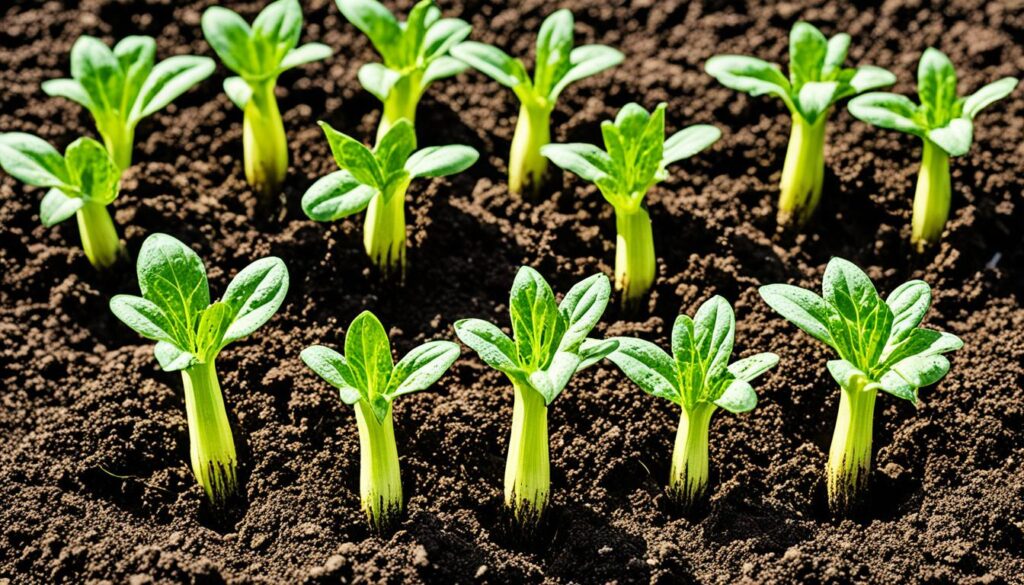
Soil and Location Requirements
Zucchini plants require specific soil and an ideal location to thrive and produce a bountiful harvest. Providing the right conditions for your zucchinis will ensure their health and productivity.
Choosing the Best Soil
Zucchini plants prefer organically rich, fertile, and well-draining soil. When planting in raised beds or containers, it is essential to select a well-draining potting soil. To enhance the soil’s fertility, add organic material or compost at the time of planting. This will help create a nutrient-rich environment for the zucchini plants to thrive.
If you are planting zucchinis directly in the ground, it is crucial to amend the soil with rich organic material or compost. This will improve the soil’s texture and provide the necessary nutrients for the plants to grow strong and healthy. Additionally, good drainage is essential for zucchini plants, as they prefer moist but not waterlogged conditions.
Choosing the Ideal Location
When selecting a location for your zucchini plants, it is important to consider their sunlight requirements. Zucchinis thrive in areas that receive full sun for at least 6-8 hours a day. Choose an area in your garden that is not shaded by buildings or trees, as this can hinder their growth and development.
Furthermore, it is important to note that zucchinis should not be planted in soil where other cucurbits (such as pumpkins or cucumbers) were grown in the past 1-2 years. This practice helps prevent the spread of diseases and pests that may affect the zucchini plants.
By providing the right soil conditions and selecting an ideal location with ample sunlight, you will create an optimal environment for your zucchini plants to flourish and produce an abundant crop.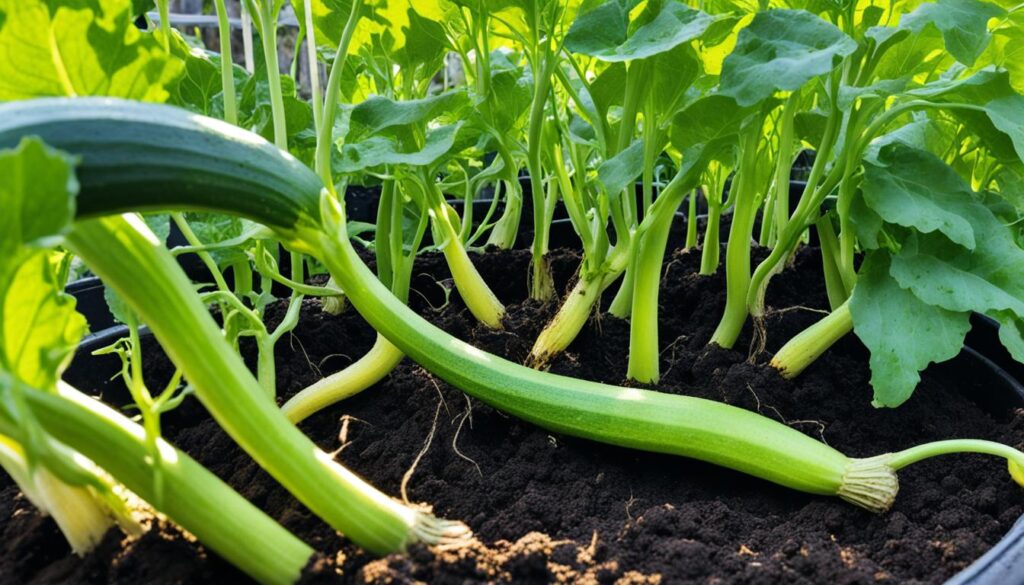
“Zucchini plants prefer organically rich, fertile, and well-draining soil. Provide the right conditions to help your zucchini plants thrive and produce a bountiful harvest.”
Spacing and Trellising
Proper spacing and trellising techniques are essential for the successful growth and development of zucchini plants.
Spacing Zucchini Plants
When it comes to zucchini plant spacing, giving enough room for each plant is crucial for optimal growth. It is recommended to space zucchini plants at least 3-4 feet apart, whether planting them in hills or rows.
For planting in hills, a general guideline is to plant 3 zucchinis per hill in a triangle pattern. Ensure the hills are also spaced 3-4 feet apart to provide enough space for the plants to receive nutrients and expand their root systems.
If growing zucchinis in containers, create a mound in the center of the container and plant three zucchinis around it. This arrangement allows for adequate airflow and efficient use of space while providing the plants with the necessary growing area.
Trellising Zucchini
Another option for maximizing space and aiding in pest management is trellising zucchini plants. By training them to grow vertically along a trellis or stakes, you can create a visually appealing and space-saving garden.
When trellising zucchini, ensure that the trellis or stakes are sturdy enough to support the weight of the plants and their fruit. As the zucchinis grow, gently guide the vines and tendrils toward the trellis, securing them with twist ties or plant clips.
The benefits of trellising zucchini include improved air circulation, which helps prevent disease, easier harvesting, and reduced pest damage since the plants are elevated off the ground.
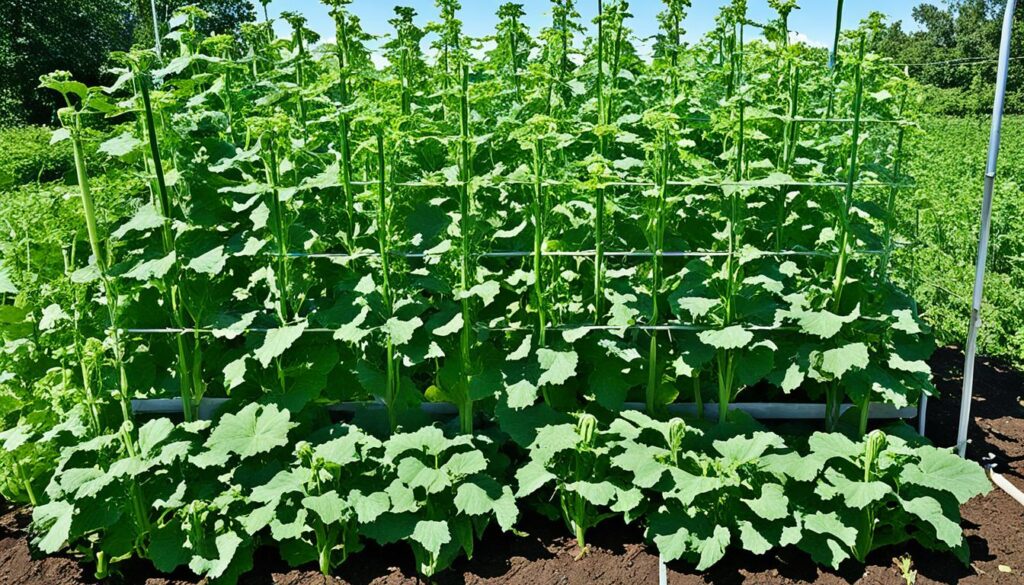
Implementing proper spacing and trellising techniques ultimately promotes healthier zucchini plants, increased productivity, and efficient use of garden space.
Pollination and Fruit Production
Zucchini plants rely on pollination for fruit production. These plants have separate male and female flowers, and the transfer of pollen from the male to the female flowers is crucial for the development of zucchini fruits. To ensure successful pollination, it’s important to understand how pollinators play a role in this process. 
Pollinators such as bees, butterflies, and other insects are attracted to the bright yellow flowers of zucchini plants. To maximize their presence in your garden, consider planting companion flowers like borage, catmint, dill, or dahlias nearby. These flowers will help attract pollinators, increasing the chances of successful pollination.
In some cases, there may be a lack of natural pollination due to factors such as weather conditions or a limited number of pollinators in the area. In such situations, manual pollination can be done to ensure fruit production. This process involves using a small brush or cotton swab to transfer pollen from the male flowers to the female flowers. By gently brushing the inside of the male flower and then transferring the pollen to the stigma of the female flower, you can help facilitate pollination.
Tip: To identify male and female flowers, look for the presence of a small zucchini-shaped swelling at the base of the female flower. Male flowers, on the other hand, do not have this swelling.
Proper pollination is essential for optimal fruit development. It ensures that the female flowers receive the necessary pollen for fertilization, leading to the formation of healthy zucchini fruits. Be sure to monitor the progress of your zucchini plants and check for signs of fruits developing from the female flowers.
When it comes to harvesting zucchini, you can do so at any size. However, larger zucchinis may have more developed seeds and a denser texture, which might not be desirable for certain recipes. In such cases, it is recommended to remove the seeds before consumption. This can be done by slicing the zucchini lengthwise and scooping out the seeds with a spoon.
Conclusion
Successful zucchini cultivation requires attention to several key factors, including avoiding squash vine borers, following proper planting techniques, providing the right soil and location, spacing plants correctly, and ensuring proper pollination. By implementing these tips and techniques, gardeners can enjoy a bountiful harvest of zucchinis that can be incorporated into a wide range of dishes.
The best way to grow zucchini is to start by carefully timing the planting, ensuring that soil temperatures are consistently above 55 degrees Fahrenheit. This warm soil temperature provides an ideal environment for germination and growth. Additionally, choosing a well-lit area with full sun for at least 6 hours a day will help zucchinis thrive.
When it comes to soil and location requirements, zucchini plants prefer organically rich and well-draining soil. Amend the soil with compost or rich organic material to promote healthy growth. Adequate spacing is essential for proper plant development, with a recommended distance of 3-4 feet between plants. Trellising zucchini plants can also save space and improve airflow.
Finally, ensuring proper pollination is crucial for maximizing fruit production. Planting companion flowers near zucchinis can attract beneficial pollinators, and manual pollination can be done to supplement natural pollination. Harvesting can be done at any size, but larger zucchinis may require seed removal before consumption.FAQ
When is the best time to plant zucchini?
How can I prevent squash vine borers from killing my zucchini plants?
What type of soil do zucchini plants prefer?
How should I space my zucchini plants?
Do zucchini plants require manual pollination?
Can I grow zucchini vertically?
- About the Author
- Latest Posts
Meet Katherine, the creative enthusiast at ByRetreat who infuses her boundless passion for design into every remote workspace she crafts. With an innate sense of creativity and an eye for unconventional beauty, Katherine brings a unique and inspiring perspective to the team.
Katherine’s love for design is infectious, and her ability to think outside the box sets her apart. She believes that true artistry lies in embracing a variety of styles and mixing them harmoniously to create captivating spaces. By combining different textures, colors, and patterns, Katherine weaves a tapestry of creativity that breathes life into each remote workspace.
Plants
Best Conditions for Ginger Root Growth Explained
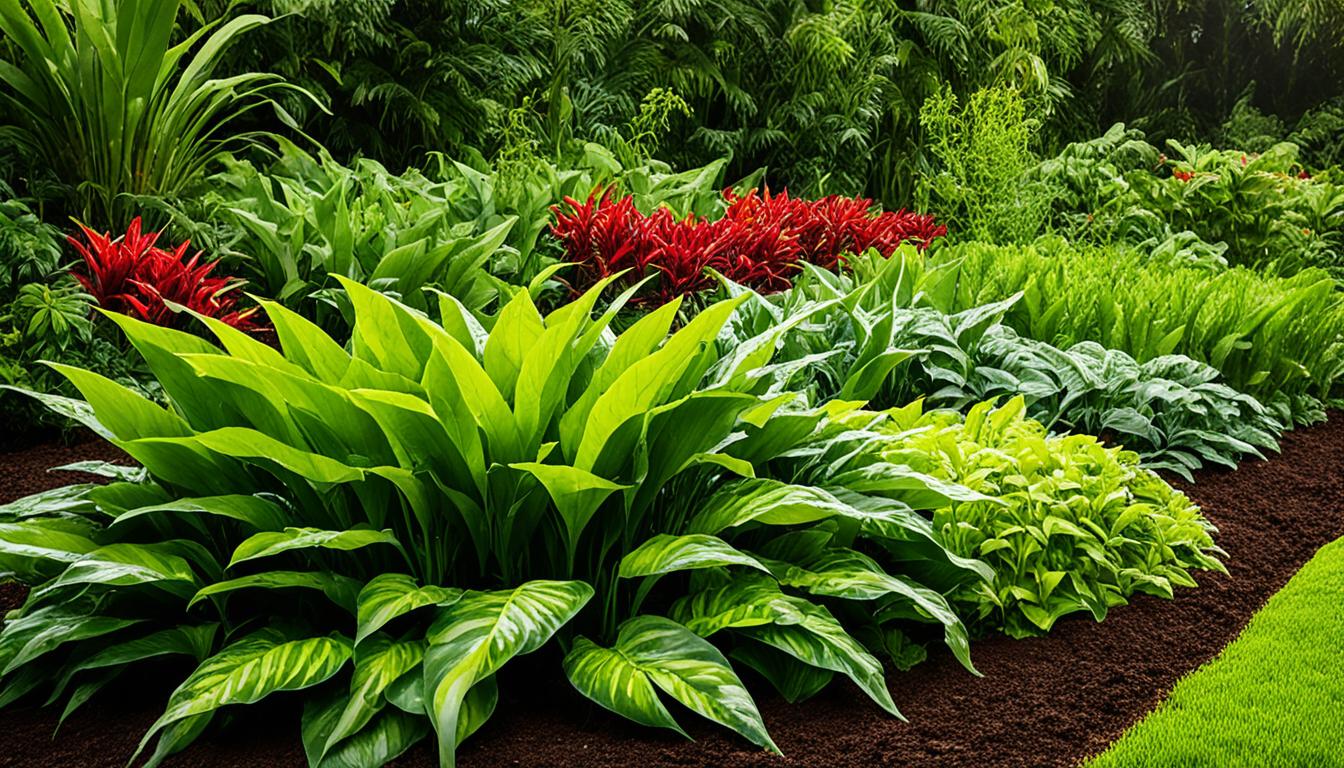
Ginger, known for its unique flavor and medicinal properties, is a versatile root used in everything from cooking to herbal remedies. But did you know that the success of ginger cultivation depends heavily on the conditions in which it is grown? Creating the best conditions for ginger root growth is essential to yield a bountiful harvest and vibrant plants.
From temperature to soil quality and moisture levels, each aspect plays a crucial role in ginger’s growth and well-being. By understanding the optimal conditions, gardeners and enthusiasts can replicate ginger’s tropical habitat and cultivate healthy plants with exceptional flavor and aroma.
In this article, we will explore the optimal conditions necessary for ginger root growth, offering insights and techniques to help you grow ginger successfully. Whether you’re an experienced gardener or a beginner with a green thumb, this guide will provide valuable knowledge to enhance your ginger cultivation.
Key Takeaways:
- Ginger root growth requires specific conditions to thrive.
- Temperature, soil quality, moisture, and shade are essential factors.
- Best practices include using organic matter, maintaining proper drainage, and providing dappled shade.
- Ginger can be grown in containers, hoop houses, or greenhouses.
- Pre-sprouting ginger indoors can maximize the growing season.
Optimal Soil Conditions for Ginger Root Growth
Ginger plants require optimal soil conditions to thrive and produce healthy root growth. By providing the right environment, gardeners can ensure that their ginger plants receive the necessary nutrients and support for robust growth. Here are some essential factors to consider when creating optimal soil conditions for ginger root growth:
- Rich in Organic Matter: Ginger prefers soil that is rich in organic matter, which provides essential nutrients and promotes healthy root development. Adding lots of compost to the ground or using a peat and wood bark-based soilless medium mixed with sand in containers can help create a fertile growing medium.
- Organic Fertilizers and Worm Castings: Supplementing the soil with organic fertilizers and worm castings can further enhance the nutrient content, ensuring that ginger plants have access to the necessary elements for their growth. These natural amendments provide a slow-release source of nutrients, promoting long-term plant health.
- Good Drainage: It is crucial to ensure good drainage in the soil to prevent waterlogging, as standing water can negatively affect ginger growth. To improve drainage, incorporating coarse sand or perlite into the soil can help create a well-draining environment for the roots.
- pH Levels: Maintaining the right pH levels is essential for optimal ginger growth. Ginger plants prefer slightly acidic soil, with pH levels between 5.5 and 6.5. Testing the soil’s pH and making appropriate adjustments using organic soil amendments or sulfur can help create the ideal conditions for ginger plants.
By creating soil conditions that are rich in organic matter, well-draining, and with the right pH levels, gardeners can provide the optimal environment for ginger root growth. The next section will explore the ideal temperature range for ginger plants and the impact it has on their growth and development.
Soil Conditions for Ginger Root Growth
| Soil Condition | Description |
|---|---|
| Rich in organic matter | Ginger prefers soil that is rich in organic matter, such as compost or a peat and wood bark-based soilless medium mixed with sand. |
| Organic fertilizers and worm castings | Adding organic fertilizers and worm castings can provide essential nutrients for ginger plants. |
| Good drainage | Ensuring good drainage in the soil is crucial to prevent waterlogging, which can negatively affect ginger growth. |
| pH levels between 5.5 and 6.5 | Maintaining slightly acidic soil with pH levels between 5.5 and 6.5 is ideal for ginger plants. |

Ideal Temperature Range for Ginger Root Growth
Ginger is a tropical plant that thrives in warm temperatures, making the ideal temperature range a crucial factor for its successful growth. The ideal temperature range for ginger root growth is 70° to 90°F (21° to 32°C). This range provides the optimal conditions for ginger plants to thrive and produce healthy rhizomes.
When growing ginger, it is important to consider the nighttime temperatures as well. It is recommended to plant ginger when nighttime temperatures are consistently above 55°F (13°C). Cooler temperatures can slow down the growth of ginger plants or even cause damage to them, hindering their development.
In regions with colder climates, it may be challenging to maintain these ideal temperatures for ginger growth. However, there are ways to overcome this obstacle and still grow ginger successfully. Growing ginger indoors in a controlled environment, such as a greenhouse or conservatory, can provide the necessary warmth for ginger plants to thrive.
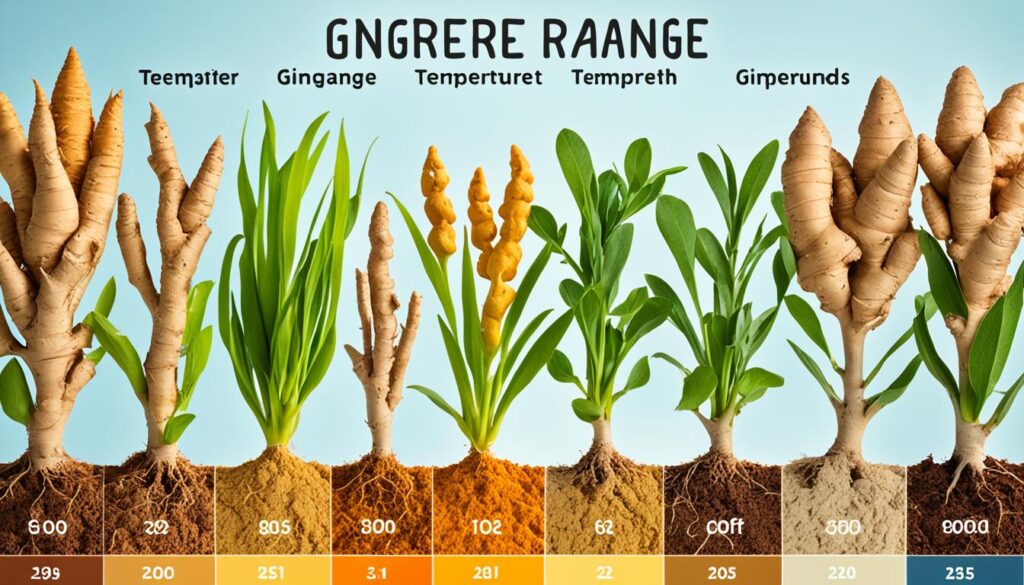
Importance of Moisture for Ginger Root Growth
Ginger is a moisture-loving plant that requires consistent watering to thrive and produce healthy and flavorful roots. Proper moisture management is essential for ginger root growth.
The soil should be kept evenly moist, providing enough water to meet the plant’s needs without overwatering or allowing the soil to dry out completely. Overwatering can lead to waterlogged conditions, which can suffocate the roots and promote the development of root rot. Conversely, letting the soil dry out completely can cause stress to the plant and hinder its growth.
Watering frequency may vary depending on factors such as the climate, humidity levels, and container size. In general, it is advisable to water ginger plants whenever the top inch of soil feels slightly dry. This allows for proper hydration without risking waterlogging.
Proper irrigation techniques and good drainage are crucial for maintaining the ideal moisture levels for ginger root growth. In containers, ensure that there are drainage holes to prevent water from pooling at the bottom. For in-ground planting, selecting a well-draining soil or amending the soil with organic matter can improve moisture balance.
Expert Tip:
When watering ginger plants, it’s important to give them a deep soak, allowing the water to penetrate the root zone. However, avoid overhead watering as it can lead to the development of fungal diseases. Instead, direct the water towards the base of the plant or use a drip irrigation system to ensure precise watering.
By maintaining the right moisture levels through proper watering techniques and good drainage, gardeners can provide the optimal conditions for ginger root growth, ensuring healthy plants and a bountiful harvest.

Moisture Guidelines for Ginger Root Growth
| Moisture Level | Signs | Recommended Action |
|---|---|---|
| Soggy or Waterlogged | Wilting, yellowing leaves; foul odor; root rot | Improve drainage by adding organic matter; reduce watering frequency |
| Too Dry | Wilting, dry soil; slow growth | Increase watering frequency; mulch around plants to retain moisture |
| Evenly Moist | Healthy foliage; steady growth | Continue regular watering; monitor moisture levels |
Benefits of Dappled Shade for Ginger Root Growth
Ginger plants thrive in dappled shade, which provides them with a balanced environment for optimal growth. The benefits of dappled shade include protection from direct sunlight, prevention of soil overheating and excessive drying, and maintenance of suitable moisture levels.
Planting ginger under the shelter of taller crops or using shade cloth can create the perfect conditions for ginger root growth. The dappled shade allows the plants to receive filtered sunlight, which is essential for photosynthesis while reducing the risk of sunburn or heat stress.
“Dappled shade is like a natural sunscreen for ginger plants, shielding them from the harsh rays of the sun and maintaining a cool, comfortable environment.”
By providing dappled shade, you can create an ideal microclimate for ginger root growth. The shade helps regulate soil temperatures, preventing it from becoming too hot and drying out too quickly. This is particularly important for ginger, as it prefers consistently moist soil.
Moreover, dappled shade helps to reduce water evaporation, allowing the roots to stay moist for longer periods. This helps the ginger plants establish a strong root system and absorb essential nutrients from the soil, promoting healthy growth and development.
When setting up dappled shade for your ginger plants, it is important to strike a balance. While providing shade, ensure that there is still enough light penetration for proper photosynthesis. Ginger plants need adequate sunlight to produce energy for growth, but too much direct sunlight can be detrimental.
Consider planting ginger in an area where it receives morning sun and partial afternoon shade. This allows the plants to benefit from the warmth and light of the morning sun while being shielded from the intense heat of the afternoon sun.
To summarize, dappled shade provides numerous benefits for ginger root growth, including protection from direct sunlight, prevention of soil overheating and excessive drying, and maintenance of suitable moisture levels. By implementing dappled shade techniques, you can create an ideal environment for ginger plants to thrive and produce a bountiful harvest.
Pros and Cons of Dappled Shade for Ginger Root Growth
| Benefits of Dappled Shade | Considerations for Dappled Shade |
|---|---|
| Protection from direct sunlight | Ensure there is still enough light for photosynthesis |
| Prevents soil overheating | Find a balance between shade and sunlight |
| Reduces soil drying out | Choose an area with morning sun and partial afternoon shade |
| Maintains suitable moisture levels |

Recommended Planting Techniques for Ginger Root Growth
When it comes to cultivating ginger, selecting the right planting technique is crucial for successful root growth. Whether using whole rhizomes or cut pieces, understanding the proper methods will optimize your ginger harvest. Here are some recommended planting techniques:
1. Using Whole Rhizomes
Planting ginger with whole rhizomes is a straightforward technique that yields excellent results. Look for healthy, plump rhizomes with well-developed buds or eyes. These larger rhizomes tend to grow quicker and produce more robust plants.
To plant whole rhizomes:
- Prepare the soil by loosening it with a garden fork or tiller.
- Dig a trench that is about 6 to 8 inches deep.
- Place the rhizomes in the trench with the eyes facing upwards.
- Cover the rhizomes with soil, ensuring they are well-buried but not too deep.
- Water gently to settle the soil.
2. Using Cut Rhizome Pieces
If you have limited planting material or want to maximize your ginger yield, using cut rhizome pieces is a viable option. When cutting the rhizomes, ensure each piece has at least one bud or eye.
To plant cut rhizome pieces:
- Prepare the soil or select a suitable container with good drainage.
- Fill the container with a well-draining potting mix or amend the soil with organic matter.
- Place the cut rhizome pieces in the soil or container, burying them about 1 to 2 inches deep.
- Water thoroughly to encourage root establishment.
Note: Make sure there is adequate room for the rhizomes to grow when planting in containers. This will prevent overcrowding and promote healthier plant development.
3. Pre-sprouting Indoors
For gardeners who wish to extend the growing season or gain a head start on ginger production, pre-sprouting indoors is an effective technique. This method involves placing the rhizomes in a tray with moist compost or paper towel to encourage early sprouting.
To pre-sprout ginger indoors:
- Select healthy rhizomes with visible eyes.
- Fill a tray with moist compost or lay paper towels on a flat surface.
- Place the rhizomes on the compost or paper towels, positioning them with the eyes facing upwards.
- Maintain the moisture level by misting regularly.
- Keep the tray or paper towels in a warm location with indirect sunlight.
- Once sprouts have developed, carefully transplant them into individual containers or directly into the ground.
Pre-sprouting allows for an earlier harvest and ensures that the ginger plants have a strong start before being exposed to outdoor conditions.
Remember, ginger responds well to a warm and humid environment, so providing the optimal conditions during the planting process will contribute to its overall growth and development.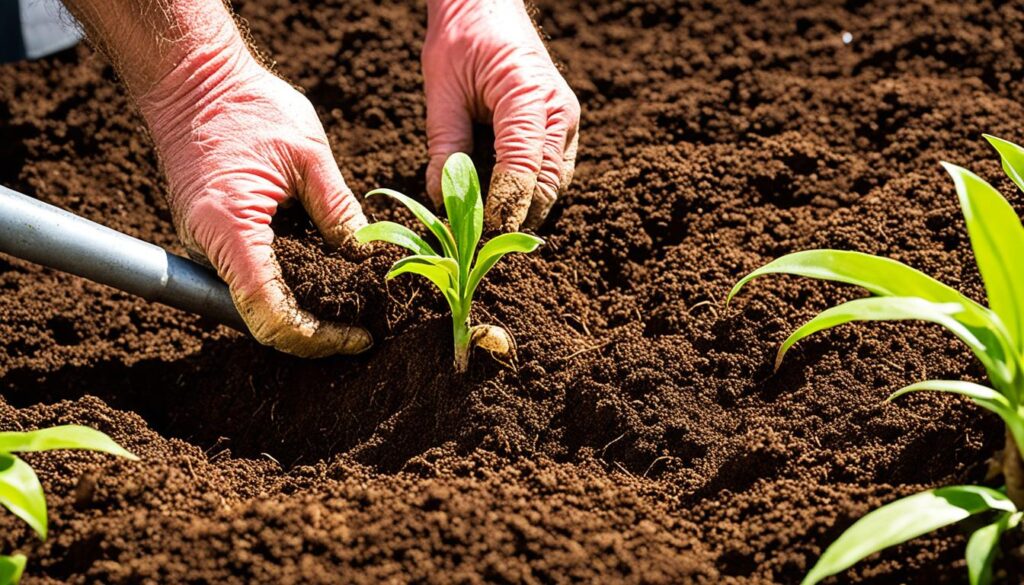
| Planting Technique | Advantages | Disadvantages |
|---|---|---|
| Using Whole Rhizomes | – Quicker growth – Larger harvests |
– Requires more planting material – Limited control over spacing |
| Using Cut Rhizome Pieces | – Maximizes planting material – Allows for precise spacing |
– Slower initial growth – Smaller rhizome yields |
| Pre-sprouting Indoors | – Provides an early start – Enhances germination rates |
– Requires additional indoor space – Requires regular misting |
Care Tips for Ginger Root Growth
Proper care is crucial for the successful growth of ginger roots. By providing the right conditions, you can ensure healthy plants and a bountiful harvest. Here are some essential care tips for ginger root growth:
1. Warmth: Ginger plants thrive in warm environments, so it’s important to provide them with a suitable temperature. During the summer, whether you are growing ginger outdoors or indoors, it’s beneficial to place the plants in a warm and humid area.
2. Humidity: Humidity is another important factor for ginger root growth. If you are growing ginger indoors, placing the plant near a bright windowsill can help simulate the ideal conditions. Additionally, occasional misting with water can create a humid environment that mimics the plant’s natural habitat.
3. Moisture: Adequate moisture levels are essential for ginger plants. It’s important to water the plants regularly, ensuring that the soil is evenly moist. However, be cautious not to overwater, as excessive moisture can lead to root rot. To promote proper drainage, use pots with drainage holes and allow the soil to dry out slightly between waterings.
4. Mulching: Applying a layer of mulch around ginger plants can serve multiple benefits. Mulching helps to conserve moisture in the soil, reducing the frequency of watering required. Additionally, it helps to suppress weed growth, keeping the area around the ginger plants clean and tidy.
Ginger plants require a combination of warmth, humidity, moisture, and proper drainage to thrive. By following these care tips, you can create optimal conditions for ginger root growth and enjoy a successful harvest.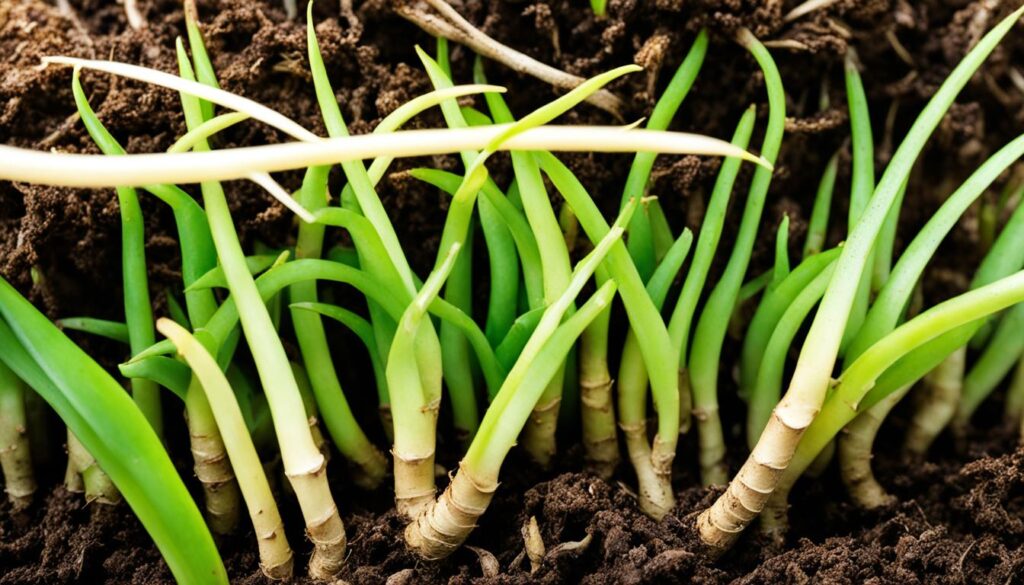
| Care Tips for Ginger Root Growth | Benefits |
|---|---|
| Provide warmth | Creates a favorable environment for ginger plants |
| Maintain humidity | Simulates the plant’s natural habitat and supports growth |
| Ensure proper moisture | Prevents drying out or waterlogging |
| Use mulch | Conserves moisture and suppresses weed growth |
Conclusion
Growing ginger successfully requires replicating its tropical natural habitat as closely as possible. Providing optimal soil conditions, the right temperature range, adequate moisture, and dappled shade is crucial. By following these best practices, gardeners can ensure the best conditions for ginger root growth and enjoy a bountiful harvest.
When it comes to planting ginger, there are two main methods: using whole rhizomes or cutting them into pieces and pre-sprouting indoors for an earlier harvest. Both approaches can be effective, but it’s important to pay careful attention to watering and drainage. Ginger cannot tolerate standing water or drying out completely, so finding the right balance is key.
Remember that ginger thrives in warm temperatures, ideally ranging from 70° to 90°F (21° to 32°C). Additionally, ginger plants appreciate some dappled shade, as it protects them from direct sunlight and helps prevent the soil from drying out too quickly. Creating these optimal conditions will give your ginger the best chance to grow and thrive.
So whether you’re growing ginger in the ground, in containers, or in a greenhouse, make sure to provide it with the right environment. By replicating its tropical natural habitat as closely as possible and paying attention to its specific needs, you can enjoy a bountiful harvest of delicious and aromatic ginger roots.
FAQ
What are the best conditions for ginger root growth?
What are the optimal soil conditions for ginger root growth?
What is the ideal temperature range for ginger root growth?
How important is moisture for ginger root growth?
What are the benefits of dappled shade for ginger root growth?
What are the recommended planting techniques for ginger root growth?
What are the care tips for ginger root growth?
- About the Author
- Latest Posts
Meet Katherine, the creative enthusiast at ByRetreat who infuses her boundless passion for design into every remote workspace she crafts. With an innate sense of creativity and an eye for unconventional beauty, Katherine brings a unique and inspiring perspective to the team.
Katherine’s love for design is infectious, and her ability to think outside the box sets her apart. She believes that true artistry lies in embracing a variety of styles and mixing them harmoniously to create captivating spaces. By combining different textures, colors, and patterns, Katherine weaves a tapestry of creativity that breathes life into each remote workspace.
-

 Vetted5 days ago
Vetted5 days ago15 Best Printers of 2024: Top Picks and Expert Reviews
-

 Vetted1 week ago
Vetted1 week ago15 Best Tile Sealers for Long-Lasting Protection and Shine
-

 Vetted2 weeks ago
Vetted2 weeks ago15 Best Smelling Floor Cleaners That Will Leave Your Home Fresh and Inviting
-

 Vetted1 week ago
Vetted1 week ago14 Best Power Scrubbers for Showers That Will Transform Your Cleaning Routine
-

 Vetted2 days ago
Vetted2 days ago15 Best Evergreen Plants for Shade Gardens: A Complete Guide
-

 Vetted2 days ago
Vetted2 days ago15 Best LED Dimmer Switches With No Flicker: Ultimate Guide for a Flicker-Free Lighting Experience
-

 Mardi Gras Decoration4 days ago
Mardi Gras Decoration4 days agoWhat Do the Symbols of Mardi Gras Mean?
-

 Appliances1 week ago
Appliances1 week ago5 Best Energy-Efficient Stainless Steel Fridges 2023






